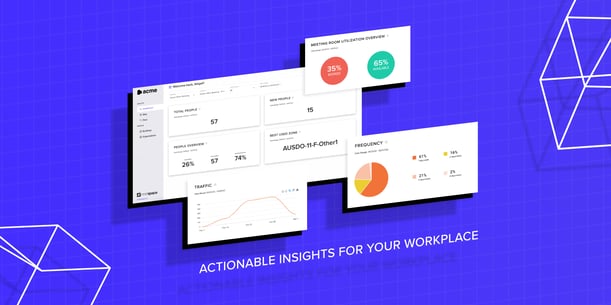Getting it Right with Data: Hybrid Workplace Strategy 2023
Why your workplace strategy needs a change
It's early 2020. You think you've got everything figured out. Your teams are in every day, your space seems well-utilized, and you can't imagine a scenario where everything gets turned on its head, in terms of the way you work. After all, your entire career has mostly been based around some sort of 9-5 week, served mostly in the office.
It's not 2020 anymore, and it won't be again (thank goodness?). A lot has changed in the last three years. Work culture has shifted in a significant, once in a generation (or maybe even a few generations) way, and the expectation is that a hybrid workplace strategy is integral to employee satisfaction. Employee satisfaction is a key part of retaining staff and ensuring your business runs efficiently, and workplace leaders know that employee needs aren't what they were in 2020.
What is the purpose of a workplace strategy?
A workplace strategy takes everything you know about the current state of work, your business goals, your current office space, your projected physical space needs, and your employee needs, and comes up with an actionable plan to best support your organization.
For those of you who like visioning exercises, it's an exciting time! For those of you who don't, you need data to support change management, and ensure your business objectives align with where your two biggest line items are; your teams and your office space.
Create a work environment with purpose

You've seen the changes in work over the past few years; the quiet quitting, the rise of the virtual meeting, your teams working off hours to manage conflicting schedules with their families. It's a different world, and to be on your game as an organization, to ensure you empower employees with progressive, well defined workplace strategy, you need to be a strategic leader that leads with data driven decisions.
A lot of hybrid work strategies have been focused on an arbitrary number, like two days in the office a week to ensure the space is being used. This is often a hard hybrid workplace strategy to get buy in on. Why? Because unless it's strategic, and in line with employee expectations, the company aims, and has clear links to a plan with strategic outcomes, it has the potential to impact workplace morale.
Employee engagement in plans is important, and if teams are working to expectation offsite, bringing them back, even a reduced amount of days to meet an arbitrary number could have unexpected impacts on company culture.
If you want your teams to come back into the office that's dynamic and responsive to the way your organization functions, it's important to understand how your workplace is being used now, and how that aligns with your future workplace goals.
Understand the current state of your workplace
Before you start mandating arbitrary days in the office, this is a great time to take a step back and understand your office dynamics, as they are today, not in relation to how they were pre-2020. Without setting conditions, here are a few questions to consider:
- What teams are coming into the office?
- How many days are they in?
- What are they doing when they're there?
- How are they using the space?
- What is the workplace environment like when people are in?
Getting the right answers to these questions will be crucial to your workplace strategy.
Alignment to business objectives
A strategic workplace strategy should also align to your business objectives and your company's current priorities. Are you looking to reduce costs? Are you intending to grow your teams in the short term? Are changes to your real estate on the horizon with a lease term ending?
Getting your space in the zone: understanding employee preferences
Over the last few years, teams got used to working differently. Patterns and habits were formed, and employee expectations around routines like school pickups, or other activities were set. Teams also got used to working and collaborating in different ways. A recent study we did with a global company in the employment and careers sector found the following information about occupancy by space type and put lounge conference rooms at the most efficient:

Some habits are best broken, but if others enable peak performance, and help the company achieve their business goals, isn't it best to find ways to ensure your workplace strategy aligns with those habits?
Maybe they mean coming in for regular meetings to mimic the breaks in the week that Zoom calls created. Maybe they mean more dedicated quiet zones in the office to mimic the working at home experience. Maybe they mean shifting the workday hours for some employees. Maybe it means working at home more in the summer. We have seen two times as many teams prefer focus spaces to collaboration spaces, which gives us an indication of preferred working styles.
Every workplace will be different, in the habits, norms, and values that help you meet your company goals, but one thing is true; before you make any sort of hybrid workplace strategy, you need to ensure you've got the right information in front of you.
Unlock an effective workplace strategy with data
A strategic leader understands how their teams work best, and even without a hybrid workplace strategy, there's a good chance that your employees might already be participating in patterns that help you meet your business goals, and encourage a positive office culture. What do these work patterns look like though? How do you measure them over time? When is the optimal time to gather data? What is the new normal for your office space?
Enter InnerSpace with workplace intelligence.
The term "workplace intelligence" generally refers to the collection, analysis, and application of data and insights related to various aspects of the workplace. This can include information about how the physical space is being utilized, how employees are using technology and other resources, and how teams are collaborating and communicating with each other.
By leveraging workplace intelligence, organizations can gain a better understanding of how to optimize their workspace for better efficiency, productivity, and employee satisfaction. This can involve making changes to the physical layout of the office, adopting new technologies or tools, or implementing new policies or procedures that support more effective collaboration and communication. Ultimately, the goal of workplace intelligence is to create a work environment that supports the needs and goals of both the organization and its employees.
Measure, learn, and adapt for workplace success

InnerSpace gives you access to actionable insights you need to design the right space for your teams in a hybrid model. We can find out which types of spaces foster collaboration, and which are key components of your office the ways your teams use it now, not in 2020. If you're looking for a better understanding of the data of work in your space to come up with an actionable workplace strategy, you need to look no further.
Start planning today
The way your teams work has changed, and it's likely that more changes that might impact your physical office may be on the way, as leases come up, and new technologies continue to augment the way we all do business. With InnerSpace, you can be ready for anything that comes your way with robust, actionable data on your space.
Are you ready make your workplace strategy meaningful and support your employee experience today and going forward? Let's talk #indoorology.
Accurate space utilization data through Wi-Fi?
We'll prove it to you.
See why industry leaders leverage InnerSpace to generate valuable insights that go beyond occupancy.

